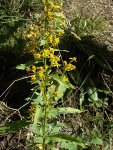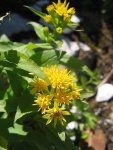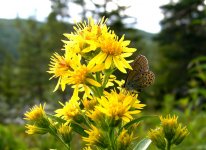Goldenrod ordinary - solidaco vircaurea l.
Family Asteraceae - Compositae
Botanical characteristics. A perennial herbaceous plant with a straight stem 20-100 cm tall, branching into the inflorescence. Rhizome short, obliquely located. Basal leaves long-petioled, ovate or oblong, serrate along margin; Stem on short petioles, upper - almost sessile, lanceolate. Flowers small golden yellow, collected in baskets, consisting of marginal and medial tubular bisexual flowers. Flower baskets are collected in a more or less long loose or dense inflorescence, less often narrow, sometimes short head. Fruit - oblong naked seed with a tuft, covered with hairs. Blooms in July - August.
The goldenrod is very polymorphic species, greatly varying in the shape of the leaves, in the size of the baskets and in their number, in the shape of the inflorescence.
Spread. It grows in forests on glades, fringes and felling, along ravines, among bushes, on mountain slopes and moss tundra.
Used parts of the plant. Medicinal raw materials are all parts of the plant, collected in the usual way; Aboveground part - during budding; Roots in the autumn; Seeds - as they mature.
Chemical composition. The aerial part of the plant contains phenolic compounds: leukocaprozide; Phenolic carboxylic acids: coffee, chlorogenic; Coumarins: esculetin, esculin; Flavonoids: rutin, astragaline; Organic acids: quinine; Terpenoids; Saponins: oleanolic, polygalic acid; Pigments, vitamins.
Inflorescences contain carbohydrates and related compounds (polysaccharides: galactose, arabinose, glucose, xylose, rhamnose); In fruits - fatty oil.
Application. All parts of the plant in the experiment are active against influenza and herpes viruses; Preparations of the aerial part have a strong diuretic effect. The extract is recommended for edema of the brain.
In folk medicine, decoctions and infusion of the aboveground part of the plant are used as a diuretic, anti-inflammatory, hemostatic, antiseptic, astringent and wound-healing agent, with kidney and bladder diseases, cholelithiasis, bronchial asthma, diabetes, arthritis, colitis, diseases of the genital area, especially in Men. In a mixture with other plants (with the roots of the nettle) are used for prostate adenoma, prostatitis, prostatic hypertrophy; Externally - with acute laryngitis, eczema.
In the Caucasus, the goldenrod is used to treat wounds; In Siberia - with ulcerative colitis, cystitis, hepatitis; In homeopathy (in the form of essence) - with nephritis, bronchial asthma, diathesis and skin diseases. Outer - in the form of lotions and compresses as wound-healing agent.
In Bulgaria, infusions and decoctions of the aboveground part of the plant are used inside and outwardly as a diuretic, with urolithiasis, rheumatism, infiltrates. In Tibetan medicine - with neurasthenia, jaundice.
Preparation
- For the infusion take 20 g of raw materials, pour 200 ml of boiling water, insist on a boiling water bath for 15 minutes, cool 45 minutes, without removing from the bath, filter, bring up to 200 ml, squeezing out the remainder. Take 2 tbsp. Spoon 3 times daily before meals.
- Tincture is prepared on 70% alcohol at a rate of 1:10. Insist 10 days, filter. Take 30-40 drops per reception 2-3 times a day before meals.
Contraindications. Internal use requires caution - you can not take pregnant women and glomerulonephritis.






Comments
When commenting on, remember that the content and tone of your message can hurt the feelings of real people, show respect and tolerance to your interlocutors even if you do not share their opinion, your behavior in the conditions of freedom of expression and anonymity provided by the Internet, changes Not only virtual, but also the real world. All comments are hidden from the index, spam is controlled.